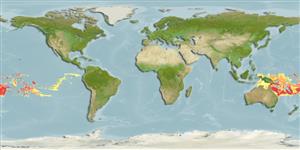Environment: milieu / climate zone / depth range / distribution range
Ekologi
laut; air tawar; payau dasar (demersal); katadromus (ruaya dari air tawar ke laut) (Ref. 51243); kisaran kedalaman ? - 3000 m (Ref. 86942). Tropical; 2°N - 27°S
Pacific Ocean: western New Guinea and Queensland, Australia to the Society Islands. A single specimen was recorded from a tributary of the Buffalo River, near King William's Town in South Africa (Ref. 3506), but this is questionable.
Size / Weight / umur
Maturity: Lm ? range ? - ? cm
Max length : 110 cm TL jantan/; (Ref. 5259); common length : 60.0 cm TL jantan/; (Ref. 5259)
vertebrata, bertulang belakang: 102 - 108. Belongs to the group of anguillas which have a short dorsal fin which originates slightly before the anus (Ref. 48622). Most closely resembles Anguilla australis and A. bicolor, from which it can be distinguished with certainty only by the number of vertebrae. Also Ref. 2847.
Inhabits freshwater streams, lakes and swamps, favouring coastal lagoons and the lower reaches of rivers. Spawning adults occur in marine waters. Sub-adults spend most of their lives in fresh or brackish waters (Ref. 44894). Found in large turbid rivers and small creeks (Ref. 2847). Occurs both in running and stagnant waters (Ref. 12790). Feeds mainly on fishes, crustaceans and mollusks.
Life cycle and mating behavior
Kematangan | Reproduksi, perkembang biakan | Pemijahan | telur-telur | Fecundity | Larva
Allen, G.R., 1989. Freshwater fishes of Australia. T.F.H. Publications, Inc., Neptune City, New Jersey. (Ref. 5259)
Status IUCN Red List (Ref. 130435)
ancaman kepada manusia
Harmless
penggunaan manusia
Perikanan: perikanan swasembada
informasi lanjut
Nama-nama umumSinonim (persamaan)metabolismePemangsaEkotoksikologiReproduksi, perkembang biakanKematanganPemijahanSpawning aggregationFecunditytelur-telurpekembangan telor
AcuanBudidaya airprofil budidaya airStrainGenetikaElectrophoresesDiturunkanPenyakit-penyakitPengolahanNutrientsMass conversion
Alat, peralatan
laporan khas
muat turun XML
Sumber internet
Estimates based on models
Preferred temperature (Ref.
123201): 3.6 - 10.2, mean 4.8 °C (based on 263 cells).
Phylogenetic diversity index (Ref.
82804): PD
50 = 0.5000 [Uniqueness, from 0.5 = low to 2.0 = high].
Bayesian length-weight: a=0.00050 (0.00030 - 0.00083), b=3.15 (3.01 - 3.29), in cm total length, based on LWR estimates for this species & Genus-body shape (Ref.
93245).
Trophic level (Ref.
69278): 4.5 ±0.80 se; based on food items.
Daya lenting (Ref.
120179): sangat rendah, Waktu penggandaan populasi minimum lebih dari 14 tahun (Preliminary K or Fecundity.).
Fishing Vulnerability (Ref.
59153): High to very high vulnerability (66 of 100).
